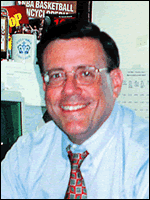|
|
 |
 |
 |
 |
|
WITHIN THE FAMILYWhither Columbia Athletics?By Alex Sachare '71
Ray Tellier is fired after 14 seasons as Columbia’s football coach, 12 of them losing seasons. The men’s basketball team loses its first six games and appears headed for a long season in a rebuilding year — if one can use that term when coming off last season’s 11–17 disappointment. Sure, Columbia athletics has its high points. The women’s cross country team had its best season ever, winning the Heptagonals and the Northeast Regionals and finishing 11th in the nationals. Men’s soccer won 10 games and should have gotten an NCAA berth, and Oscar Chow ’03 had a great fall tennis season, giving much hope for the spring. And there’s always fencing, thank you. But the marquee sports, football and men’s basketball, are at a crossroads. As this is written, a committee has begun the process of selecting the new football coach, and basketball has just posted its first win of the season, over Army, to stand at a shaky 1–6. Where are these sports headed? At President Lee C. Bollinger’s inauguration ceremony, NYC Mayor Michael Bloomberg drew the biggest laugh of the day by noting how Bollinger was moving from one football powerhouse to another. When you think about it, however, Bollinger’s Saturday experiences at Michigan and its 107,501-seat stadium are likely to influence the direction of Columbia’s football program. Bollinger has said he views athletics, both intercollegiate and intramural, as a vital part of the college experience. And he is a competitive man, hardly one to accept losing with a shrug and to settle for mediocrity, or less. The choice of the next coach presents an opportunity to take a major step toward turning the football program around. Columbia’s next coach should be both dynamic and diligent. He should inspire players to have faith in the program and inspire fans, especially students and alumni, to show up on Saturdays at Baker Field. He also should be detail-oriented; Columbia should never be unprepared for something an opponent tries, or need to call a timeout because of indecision from the bench. We expect this type of preparation, as well as the ability to inspire students, from our faculty. We should expect the same from our coaches. The ideal coach should be familiar with the realities of Ivy League football and Columbia football, having worked either here or at another Ivy as an assistant coach. It’s important that he fully understands the challenge ahead, and the issues he will need to confront. He also should have college head coaching experience, ideally having turned around a program at a small school that also has high academic standards. And he must be able to recruit. This is vital for success. The new head coach must attract talented scholar-athletes to his program in significant numbers, and keep them there. This should not be an impossible dream. Columbia is a hot school, with more than 15,000 applicants, already self-selected, vying for 1,000 places in each class. There is no more stimulating environment than New York City, and young people willing to step up and tackle both the school and the city are the type the football program needs. Yes, it’s unfortunate that Baker Field is five miles from Morningside Heights, and that travel time can eat into players’ busy schedules. To his credit, Bollinger already has spoken about trying to find (or create) practice space closer to campus for the football team and others. This would help, and is something already done at some other Ivies. As for men’s basketball, it again comes back to recruiting. I find it stunning that in this hoops mecca, Columbia cannot attract at least a couple of blue-chip prospects each year, players capable of playing at the highest level and of meeting the school’s admission standards. That’s all you need — two or three quality players each year. If head coach Armond Hill can’t recruit them, he must get an assistant or two who can, or else his program is doomed to mediocrity. And Columbia never should settle for mediocrity.
|
|
||||||||||||||||||||||||||||||||||||||||||||||||||||||||
